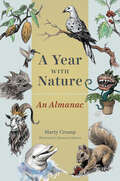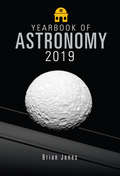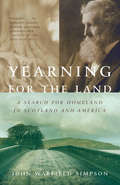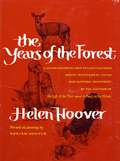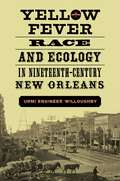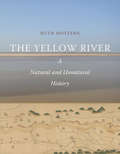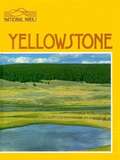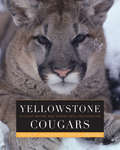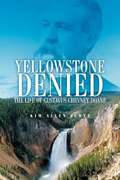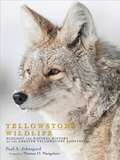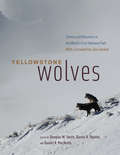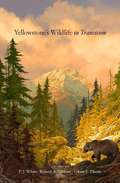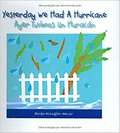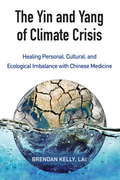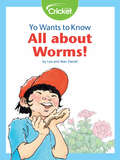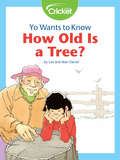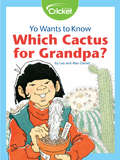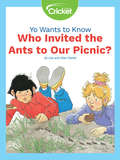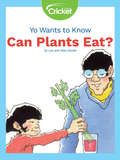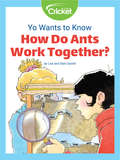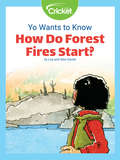- Table View
- List View
A Year with Nature: An Almanac
by Marty Crump Bronwyn McIvorA Year with Nature is an almanac like none you’ve ever seen: combining science and aesthetics, it is a daily affirmation of the extraordinary richness of biodiversity and our enduring beguilement by its beauty. With a text by herpetologist and natural history writer Marty Crump and a cornucopia of original illustrations by Bronwyn McIvor, this quirky quotidian reverie gazes across the globe, media, and time as it celebrates date-appropriate natural topics ranging from the founding of the National Park Service to annual strawberry, garlic, shrimp, hummingbird, and black bear festivals. With Crump, we mark the publication of classics like Carson’s Silent Spring and White’s Charlotte’s Web, and even the musical premiere of Tchaikovsky’s Swan Lake. We note the discovery of the structure of DNA and the mountain gorilla, the rise of citizen science projects, and the work of people who’ve shaped how we view and protect nature—from Aristotle to E. O. Wilson. Some days feature US celebrations, like National Poinsettia Day and National Cat Day; others highlight country-specific celebrations, like Australia’s Wombat Day and Thailand’s Monkey Buffet Festival, during which thousands of macaques feast on an ornately arranged spread of fruits and vegetables. Crump also highlights celebrations that span borders, from World Wildlife Conservation Day to International Mountain Day and global festivities for snakes, sea turtles, and chocolate. Interweaving fascinating facts on everything from jellyfish bodies to monthly birth flowers with folkloric entries featuring the Loch Ness Monster, unicorns, and ancient Greek, Roman, and Egyptian mythology, the almanac is as exhaustive as it is enchanting. A Year with Nature celebrates the wonder and beauty of our natural world as we have expressed it in visual arts, music, literature, science, natural history, and everyday experience. But more than this, the almanac’s vignettes encourage us to contemplate how we can help ensure that future generations will be able to enjoy the landscapes and rich biodiversity we so deeply cherish.
Yearbook of Astronomy, 2019
by Brian JonesAn inspiration to amateur and professional astronomers alike, the Yearbook of Astronomy warrants a place on the bookshelf of all sky watchers and stargazers. Maintaining its appealing style and presentation, the Yearbook of Astronomy 2019 contains an authoritative set of sky charts and comprehensive jargon-free monthly sky notes to enable backyard astronomers everywhere to plan their viewing of the years eclipses, comets, meteor showers and deep sky objects.In addition, a variety of entertaining and informative articles present the reader with information on a wide range of topics including, among others, The Cassini-Huygens Mission to the Saturn System; 100 Years of the International Astronomical Union; The First Micro-Quasar; Getting the Measure of Double Stars; Asaph Hall: Man of Mars; and Science Fiction and the Future of Astronomy.The Yearbook of Astronomy has been around for well over half a century and, as it heads towards its Diamond Jubilee edition in 2022, continues to be essential reading for anyone lured by the magic of astronomy and who wants to extend their knowledge of the Universe and the wonders it plays host to.
Yearning for the Land: A Search for the Importance of Place
by John W. SimpsonA beautiful, meditative memoir mixed with travel and history, this unique book is the story of one American's search for a deeper connection to the land. Drawn by a sense that he is missing a critical link to his home in suburban Ohio, John W. Simpson heads for rural Scotland, where he encounters his own family history as well as estate owners and tenant farmers who have centuries-long ties to their land. As he travels, he meditates on the legacy of the great 19th century conservationist John Muir, who himself developed a complex love of the land when he immigrated from Scotland's North Sea coast to the fields and forests of Wisconsin. As Simpson physically retraces Muir's journey he wonders what sense of belonging Muir found on the frontier that modern America, with its strip malls and housing developments, has forgotten. A fascinating story of changing perceptions and values from the Old World to the New, Yearning for the Land shows us just how much roots matter--both in our own lives, and in the many ways time and history, landscape and community are tightly intertwined.From the Trade Paperback edition.
The Years of the Forest
by Helen HooverFrom the book: What does it really mean, what does it really entail day by day, to give up urban comforts for the deeper delights of wilderness living? One day, shortly after Helen and Adrian Hoover first fled city life to make a home for themselves in a remote cabin in the Minnesota woods, Ade scribbled a casual list (the last item then seemed almost a whimsical joke) of Things to Do: clear brush, install wiring, Clear paths, put in running water, clear trash, inside toilet, remodel icehouse, clear small cabin, Build dock, Cut wood, Lay hardwood floor, get another car, fix roof, make a living, Finish inside, Take a vacation. it was a random enough list. It didn't even include such matters as Food, Telephone (of course there was none in the isolated cabin). Other books by Helen Hoover are available from Bookshare.
YEARS OF THE FOREST
by Helen HooverThis is a book that takes us inside the Hoovers' wilderness home during those sixteen Years of the Forest and lets us experience not only the joys and the techniques but also the challenges and travails of going it alone in the beautiful but not always accommodating wilderness, far from the technology and services that city people take for granted. It is a book of wilderness adventure, it is an education in the ingenuities of wilderness housekeeping, filled with practical details about making do, building and rebuilding, gardening for fun and for food, even advice about getting away from getting-away-from-it-all. Good times and Hard times, good neighbors and bad neighbors, the strains engendered by conflicting views--and passions--about the use of the environment: Mrs. Hoover shares her experience without stint. But above all--over, under, and all around her straightforward and practical approach to life in the wilderness--there is, as always, the sensitive and moving awareness of nature (especially of the animals with whom she and her husband shared the forest, often helping them through starving winters) that is the special quality of her writing and her life.
Yellow Eyes
by Rutherford MontgomeryYellow Eyes raised and faced about. His amber eyes shone and his ears were laid back. In an instant he struck again and sent the leader of the pack hurtling from the cliff. Against dogs, man, and natural enemies the fierce American cougar fights to keep his rule supreme in the high mountain country of the West.
Yellow Fever, Race, and Ecology in Nineteenth-Century New Orleans (The Natural World of the Gulf South #8)
by Urmi Engineer WilloughbyThrough the innovative perspective of environment and culture, Urmi Engineer Willoughby examines yellow fever in New Orleans from 1796 to 1905. Linking local epidemics to the city’s place in the Atlantic world, Yellow Fever, Race, and Ecology in Nineteenth-Century New Orleans analyzes how incidences of and responses to the disease grew out of an environment shaped by sugar production, slavery, and urban development.Willoughby argues that transnational processes—including patterns of migration, industrialization, and imperialism—contributed to ecological changes that enabled yellow fever–carrying Aedes aëgypti mosquitoes to thrive and transmit the disease in New Orleans, challenging presumptions that yellow fever was primarily transported to the Americas on slave ships. She then traces the origin and spread of medical and popular beliefs about yellow fever immunity, from the early nineteenth-century contention that natives of New Orleans were protected, to the gradual emphasis on race as a determinant of immunity, reflecting social tensions over the abolition of slavery around the world.As the nineteenth century unfolded, ideas of biological differences between the races calcified, even as public health infrastructure expanded, and race continued to play a central role in the diagnosis and prevention of the disease. State and federal governments began to create boards and organizations responsible for preventing new outbreaks and providing care during epidemics, though medical authorities ignored evidence of black victims of yellow fever. Willoughby argues that American imperialist ambitions also contributed to yellow fever eradication and the growth of the field of tropical medicine: U.S. commercial interests in the tropical zones that grew crops like sugar cane, bananas, and coffee engendered cooperation between medical professionals and American military forces in Latin America, which in turn enabled public health campaigns to research and eliminate yellow fever in New Orleans.A signal contribution to the field of disease ecology, Yellow Fever, Race, and Ecology in Nineteenth-Century New Orleans delineates events that shaped the Crescent City’s epidemiological history, shedding light on the spread and eradication of yellow fever in the Atlantic World.
The Yellow River: A Natural and Unnatural History (Yale Agrarian Studies Series)
by Ruth MosternA three-thousand-year history of the Yellow River and the legacy of interactions between humans and the natural landscape From Neolithic times to the present day, the Yellow River and its watershed have both shaped and been shaped by human society. Using the Yellow River to illustrate the long-term effects of environmentally significant human activity, Ruth Mostern unravels the long history of the human relationship with water and soil and the consequences, at times disastrous, of ecological transformations that resulted from human decisions. As Mostern follows the Yellow River through three millennia of history, she underlines how governments consistently ignored the dynamic interrelationships of the river&’s varied ecosystems—grasslands, riparian forests, wetlands, and deserts—and the ecological and cultural impacts of their policies. With an interdisciplinary approach informed by archival research and GIS (geographical information system) records, this groundbreaking volume provides unique insight into patterns, transformations, and devastating ruptures throughout ecological history and offers profound conclusions about the way we continue to affect the natural systems upon which we depend.
Yellowstone
by Carol MarronDescribes the geography, including the geysers, hot springs, mud pots, and fumaroles, and plants and animals of Wyoming's Yellowstone Park. Includes a history of the park.
Yellowstone Cougars: Ecology before and during Wolf Restoration
by Toni K. Ruth Polly C. Buotte Maurice G. HornockerYellowstone Cougars examines the effect of wolf restoration on the cougar population in Yellowstone National Park—one of the largest national parks in the American West. No other study has ever specifically addressed the theoretical and practical aspects of competition between large carnivores in North America. The authors provide a thorough analysis of cougar ecology, how they interact with and are influenced by wolves—their main competitor—and how this knowledge informs management and conservation of both species across the West. Of practical importance, Yellowstone Cougars addresses the management and conservation of multiple carnivores in increasingly human-dominated landscapes. The authors move beyond a single-species approach to cougar management and conservation to one that considers multiple species, which was impossible to untangle before wolf reestablishment in the Yellowstone area provided biologists with this research opportunity. Yellowstone Cougars provides objective scientific data at the forefront of understanding cougars and large carnivore community structure and management issues in the Greater Yellowstone Ecosystem, as well as in other areas where wolves and cougars are reestablishing. Intended for an audience of scientists, wildlife managers, conservationists, and academics, the book also sets a theoretical precedent for writing about competition between carnivorous mammals.
Yellowstone Denied: The Life of Gustavus Cheyney Doane
by Kim Allen ScottFrontier soldier and explorer extraordinaire, Gustavus Cheyney Doane was no stranger to historical events. Between 1863 and 1892, he fought in the Civil War, participated in every major Indian battle in Montana Territory, and led the first scientific reconnaissance into the Yellowstone country. He was always close to being at the right place at the right time to secure lasting fame, yet that fame eluded him, even after his death. Finally, Kim Allen Scott rescues Doane from obscurity to tell the tale of an educated and inventive man who strove in vain for recognition throughout his life. Yellowstone Denied is a psychological portrait of a complex and intriguing individual. Raised in the West after traveling the Oregon Trail with his family, Doane enlisted in the “California Hundred” to fight for the Union. After a failed foray into politics, he returned to the army and headed the military escort of the first government exploration of Yellowstone in 1870. His report on that expedition attracted congressional recognition and contributed to the establishment of Yellowstone National Park but did not make Doane a household name. He fought the Sioux in 1876, the Nez Perces in 1877, and Geronimo in 1886. He also took part in preparations for the ill-fated Greeley Arctic expedition of 1881. During his thirty years in uniform, Doane nearly achieved the celebrity he sought, but twists of fate and, at times, his own questionable behavior denied it in the end. Scott’s critical biography now examines the man’s accomplishments and failures alike, and traces the frustrated efforts of Doane’s widow to see her husband properly enshrined in history. Yellowstone Denied is also a revealing look at military culture, scientific discovery, and western expansion, and it gives Doane the credit long denied him.
Yellowstone Wildlife: Ecology and Natural History of the Greater Yellowstone Ecosystem
by Paul A. JohnsgardYellowstone Wildlife is a natural history of the wildlife species that call Yellowstone National Park and the Greater Yellowstone Ecosystem their home. Illustrated with stunning images by renowned wildlife photographer Thomas Mangelsen, Yellowstone Wildlife describes the lives of species in the park, exploring their habitats from the Grand Tetons to Jackson Hole. From charismatic megafauna like elk, bison, wolves, bighorn sheep, and grizzly bears, to smaller mammals like bats, pikas, beavers, and otters, to some of the 279 species of birds, Johnsgard describes the behavior of animals throughout the seasons, with sections on what summer and autumn mean to the wildlife of the park, especially with the intrusion of millions of tourists each year. Enhanced by Mangelsen’s wildlife photography, Yellowstone Wildlife reveals the beauty and complexity of these species’ intertwined lives and that of Yellowstone’s greater ecosystem.
Yellowstone Wildlife
by Paul A. JohnsgardYellowstone Wildlife is a natural history of the wildlife species that call Yellowstone National Park and the Greater Yellowstone Ecosystem their home. Illustrated with stunning images by renowned wildlife photographer Thomas Mangelsen, Yellowstone Wildlife describes the lives of species in the park, exploring their habitats from the Grand Tetons to Jackson Hole.From charismatic megafauna like elk, bison, wolves, bighorn sheep, and grizzly bears, to smaller mammals like bats, pikas, beavers, and otters, to some of the 279 species of birds, Johnsgard describes the behavior of animals throughout the seasons, with sections on what summer and autumn mean to the wildlife of the park, especially with the intrusion of millions of tourists each year. Enhanced by Mangelsen's wildlife photography, Yellowstone Wildlife reveals the beauty and complexity of these species' intertwined lives and that of Yellowstone's greater ecosystem.
Yellowstone Wolves: Science and Discovery in the World's First National Park (America's Animal Comebacks Ser.)
by Douglas W. Smith Daniel R. MacNulty Daniel R. StahlerIn 2020, it will have been twenty-five years since one of the greatest wildlife conservation and restoration achievements of the twentieth century took place: the reintroduction of wolves to the world’s first national park, Yellowstone. Eradicated after the park was established, then absent for seventy years, these iconic carnivores returned to Yellowstone in 1995 when the US government reversed its century-old policy of extermination and—despite some political and cultural opposition—began the reintroduction of forty-one wild wolves from Canada and northwest Montana. In the intervening decades, scientists have studied their myriad behaviors, from predation to mating to wolf pup play, building a one-of-a-kind field study that has both allowed us to witness how the arrival of top predators can change an entire ecosystem and provided a critical window into impacts on prey, pack composition, and much else. Here, for the first time in a single book, is the incredible story of the wolves’ return to Yellowstone National Park as told by the very people responsible for their reintroduction, study, and management. Anchored in what we have learned from Yellowstone, highlighting the unique blend of research techniques that have given us this knowledge, and addressing the major issues that wolves still face today, this book is as wide-ranging and awe-inspiring as the Yellowstone restoration effort itself. We learn about individual wolves, population dynamics, wolf-prey relationships, genetics, disease, management and policy, newly studied behaviors and interactions with other species, and the rippling ecosystem effects wolves have had on Yellowstone’s wild and rare landscape. Perhaps most importantly of all, the book also offers solutions to ongoing controversies and debates. Featuring a foreword by Jane Goodall, beautiful images, a companion online documentary by celebrated filmmaker Bob Landis, and contributions from more than seventy wolf and wildlife conservation luminaries from Yellowstone and around the world, Yellowstone Wolves is a gripping, accessible celebration of the extraordinary Yellowstone Wolf Project—and of the park through which these majestic and important creatures once again roam.
Yellowstone's Wildlife in Transition
by P. J. White Robert A. Garrott Glenn E. PlumbThe world's first national park is constantly changing. How we understand and respond to recent events putting species under stress will determine the future of ecosystems millions of years in the making. Marshaling expertise from over 30 contributors, Yellowstone's Wildlife in Transition examines three primary challenges to the park's ecology.
Yesterday We Had a Hurricane / Ayer Tuvimos Un Huracán
by Deirdre McLaughlin MercierThis bilingual edition re-tells the experience of a hurricane as seen through the eyes of a young child. Young readers will learn all about these big storms that come from the ocean. They'll find out about the effects of wind and rain, as well as some of the more lighthearted and practical alternatives to doing without electricity.
The Yin and Yang of Climate Crisis
by Brendan KellyThe first book to marry western environmentalism with Chinese medicine, The Yin and Yang of Climate Crisis illustrates the many ways that our personal well-being and climate health are vitally connected. Brendan Kelly demonstrates that crises such as melting ice caps, dying forests, and devastating floods are symptoms of deeper issues, both within us as individuals and within our culture. Informed by Kelly's experience as a practitioner of traditional Chinese medicine, this passionate discussion reveals that the current life-threatening severity of climate change speaks to the level of imbalance that exists in the people and institutions responsible for the crisis. Considering issues such as loss of life from increasingly severe storms, stress on farmers from rapidly changing weather, and increasing rates of disease, this book goes on to present hopeful, deep-reaching personal and societal remedies to treat the underlying causes of climate change and to restore our own health. The Yin and Yang of Climate Crisis blends the external focus of environmentalism--western science, policy issues, regulations--with the internal focus of Chinese medicine--personal health, balancing Qi, diet--to present a holistic view of our interrelationship with the planet. Kelly provides a deeper look at how we've gotten to this place of climate destabilization and ways to treat both the symptoms and their root causes. Looking through the lens of Chinese medicine, we are better able to understand that the severity of climate destabilization speaks to deeper philosophical and spiritual issues and provides an opportunity to address our own personal and collective imbalances. With his unique perspective and far-reaching perceptions, Kelly encourages us to translate the reality of our warming planet into an opportunity to ask bigger and deeper questions, including who we are, what we're here to do, and what promotes health and healing.
Yo Wants to Know: All about Worms!
by Lea DanielYo finds a big worm in the garden and Grandpa tells him why these worms are so helpful.
Yo Wants to Know: How Old Is a Tree?
by Lea DanielGrandpa surprises Yo with a tree to plant for his birthday, so the two can grow tall together.
Yo Wants to Know: Which Cactus for Grandpa?
by Lea DanielGrandpa teaches Yo about how cactuses grow, thrive, and protect themselves.
Yo Wants to Know: Who Invited the Ants to Our Picnic?
by Lea DanielYo and Jennifer are having a cookie picnic when some uninvited guests show up – ants! Yo and Jennifer learn more about their new ant friends, like what they eat and where they live.
Yo Wants to Know: Can Plants Eat?
by Lea and Alan DanielTake a guess—how do you think plants eat? Yo and his dad decide to find out! They put together an experiment with celery, water, and food coloring to see how the celery might eat. What do you think Yo learns?
Yo Wants to Know: How Do Ants Work Together?
by Lea Daniel Alan DanielYo and Jennifer are learning about an ant community by watching an ant farm! Yo uses a magnifying glass to see the tiny tunnels the ants have made. Yo and Jennifer are excited to see what the ants will do in their rooms next!
Yo Wants to Know: How Do Forest Fires Start?
by Lea Daniel Alan DanielYo learns an important rule about using a campfire when she goes camping with her mother and father.Yo notices land destroyed by a forest fire. Campfires can start just from a small spark hidden in the coals of a campfire and a little wind! Yo discovers how forest fires can start and how to prevent them. What does Yo learn about being safe with campfires? How would you put out a fire?
